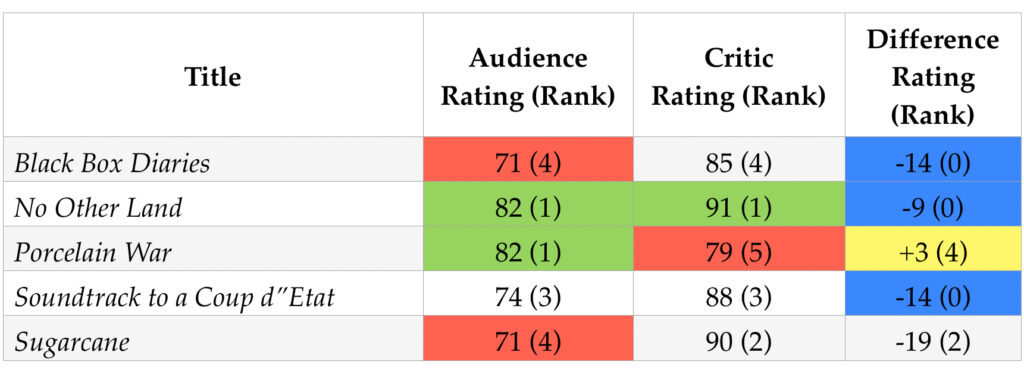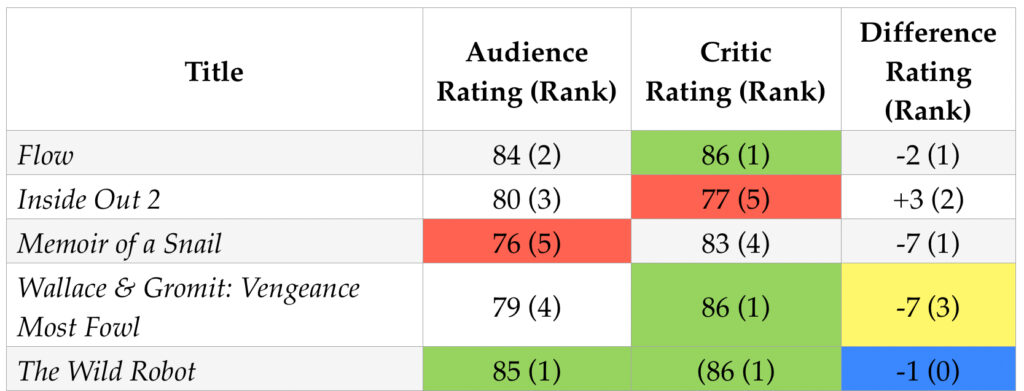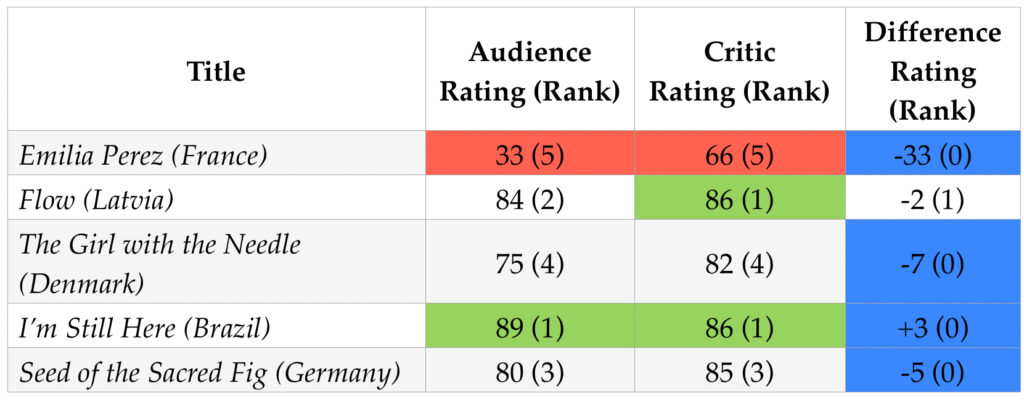After assessing the 2025 Oscar nomination patterns and how the Academy tends to look at them, I next like to assess what the current view is of the films by the two other movie communities – the viewing public and film critics – that make a difference in determining a movie’s impact. Both of these communities have different ways of looking at a movie, and it is instructive to understand what they think about any given film, especially compared to the others in the Oscar races. Assessed over a group of films, we can establish relative rankings based on their ratings. This essay covers the 15 Special Interest movies. The second one will deal with the remaining 24 General Interest movies. For my definitions of these and other terms, I refer you to the first essay, Initial Analysis.
(There are data tables presented in each of the three sections below. They all follow the same format. To understand what the numbers and colors mean, please go to the bottom of this essay.)
2025 Oscar Documentary Feature Films

Several points emerge from these numbers. In the first place, critics generally rate documentaries higher than the viewing public, and that is reflected in the differences in the scores – four of the films show a medium to large difference, while the fifth shows a very small difference in the other direction. The key point, however, is how remarkably close the viewing public and the critics were in their relative rankings. Only Porcelain War showed a large difference between the two groups, with critics finding it the worst of the five and audiences ranking it in a tie with the leader, No Other Land. I don’t know what Porcelain War is about, so I can’t explain this result yet, but it will be something to talk about when we get to the documentaries. Sugarcane had the largest difference between audience and critic rating scores, but because critics generally rate documentaries higher than audiences, I used their rankings for comparison, not the raw scores. Overall, I think we can conclude that No Other Land is likely the best documentary because both groups rated it first. And Black Box Diaries is likely the worst. In between is difficult to determine, but perhaps the most interesting one will be Porcelain War.
2025 Oscar Animated Feature Films

While critics generally rate documentaries higher than audiences, the reverse pattern usually applies to animated films. However, this year, there isn’t much difference in either the ratings or the relative rankings. The picture is complicated somewhat because the average critic ratings for three of the films are identical, placing those three films at the number one position. Considering both ratings, however, I would expect that The Wild Robot is our best animated film this year, with Memoir of a Snail likely the worst. I should note that The Wild Robot is also a General Interest film by virtue of it having received two additional minor-category nominations, and that gives that film a boost in this race. It should also be noted that Flow is nominated in the International Feature category, from Latvia, no less. Multiple nominations often help movies in this category. In short, this is a tight race.
2025 Oscar International Feature Films

This data shows what has to be the most curious element of this year’s Oscar nominations. While Emilia Perez is the darling of the Oscars, with the most nominations (13) and the highest OQI of all 35 of this year’s films (21), it is the least favorite of both the audiences and the critics – in fact, based on the ratings, both groups hated it. Audience ratings have dropped through the floor – I have never seen an Oscar-nominated movie with ratings this low. Part of the explanation may lie with the scandalous posts made by the leading actress years ago, and another part might lie with the transgender subject matter. And, unfortunately, when people get really enthused or agitated about a movie, the groups they belong to often employ bots to jack up, or down, an online rating system such as the metrics I use. And that tends to eviscerate their usefulness. (There is a definite argument here for rating systems to employ measures to filter out spurious ratings, but I’m sure that is easier said than done.)
Emilia Perez aside, what is remarkable about the ratings of the other four movies is how close the two groups rated each film, resulting in nearly identical rankings. Based on these numbers, it seems that I’m Still Here from Brazil is likely our best International Feature, and The Girl with the Needle from Denmark is the worst, although still rating as a pretty good film.
I should also note that both Emilia Perez and I’m Still Here have “crossed over” into the General Interest category. In fact, both of them have been nominated for Best Picture. Foreign films have increasingly made this leap, and I’ve argued elsewhere that at some point it seems likely that the category might disappear altogether as we consider cinema to be a worldwide enterprise, not subject to national borders and categories.
Reading the Data Tables:
Column 1: The title of the movie in this comparison.
Column 2: The general/public audience reaction to this film. The first number is the rating I have calculated, based on two public rating scales and for which I have modified them to make them comparable. A green background indicates the film is ranked highest. A red background means it comes in last. When there are more than one movie of the same color, that is because they achieved the same numerical rating.
Column 3: Same as Column 2 except for the critical assessments as aggregated by two different sources.
Column 4: The difference between the Audience and Critic ratings and ranks. The first number is the difference in rating. A negative number means the critics rated the film that much higher than the public. A positive number shows those films the public liked better than the critics. The number in parentheses is the numerical difference in rank number. A blue background is where there was no relative difference between the two groups – the ratings might be different, but their ranking in this set of films isn’t meaningful. A yellow background shows a difference of opinion on the relative value of that film compared to the others in this group.
Measurement Notes:
I have identified some anomalies in the data on the following films, which suggest that some of the conclusions presented above might be suspect. This most often (but not in the case of Emilia Perez) occurs because of a very small sample:
Emilia Perez: Major differences in both the internal audience and critic scales – the reactive data to this film is a mess and is difficult to interpret.
Porcelain War: Strong difference in the critic scales and the audience scales.
Black Box Diaries: Strong difference in the audience scales.
Soundtrack to a Coup d’État: Strong difference in the audience scales.
Inside Out 2: Modest differences in the audience scales.

